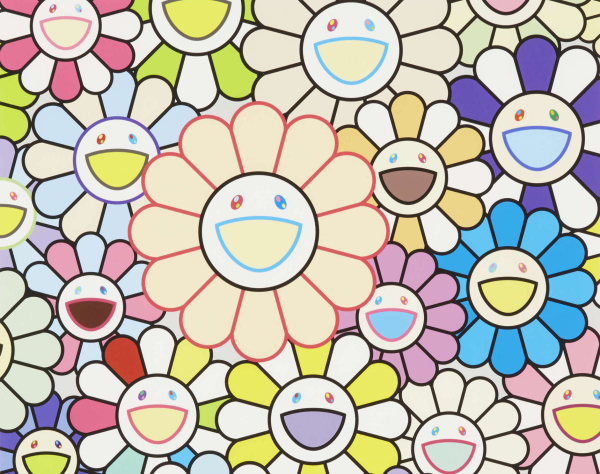
Interested in Selling?
Request a valuation
Interested in Selling?
Request a valuationTakashi Murakami 村上 隆, is a Japanese contemporary artist, working in fine arts and commercial media, drawing inspiration from traditional Japanese painting, sci-fi, anime, manga and the global art market. Referencing the likes of Damien Hirst and Bill Gates as influences, his wide-ranging art embodies an intersection of pop culture, history and fine art and is highly profitable. One of the biggest names in the contemporary art world today, the Japanese artists work is immediately recognisable for its popping, candylike colours and anime-esque aesthetic. Although Murakami is often compared to Andy Warhol his art is not to be written off as just another Pop art movement, as his work is highly informed by the immense Japanese art-historical traditions.
Here we get to know the artist famous for blurring the line between high and low arts better.
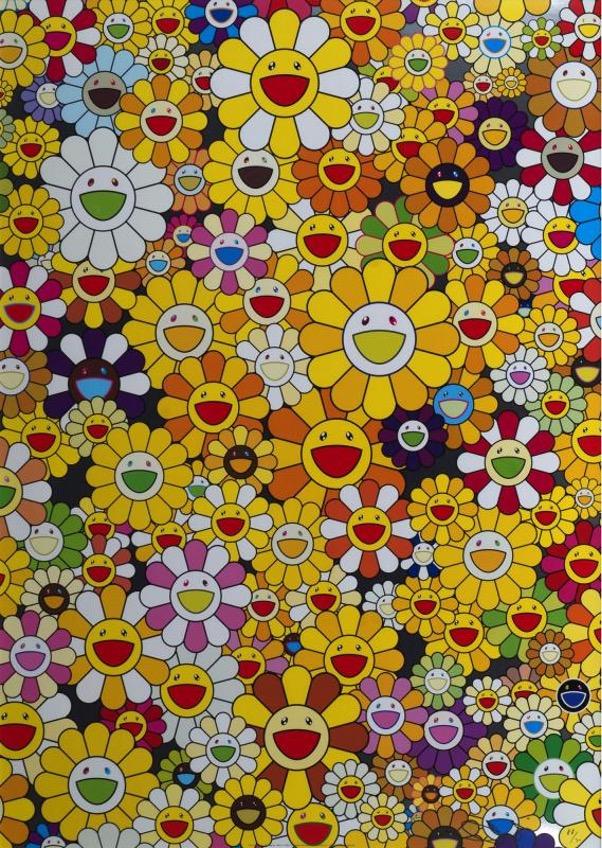
Takashi Murakami Japanese b.1962- ''An Homage to Monogold, 1960A'' 2012; offset lithograph printed in colours sold at Roseberys, Modern & Contemporary Prints & Multiples auction for £1000
Takashi Murakami was born (Born February 1, 1962) and raised in Tokyo, Japan. From early on, he was interested in anime and manga, and hoped to work in the animation industry. Murakami earned a BA, MFA, and PhD from Tokyo University of the Arts, where he studied nihonga (traditional Japanese painting). After witnessing the rise of anime and manga in Japanese culture during the '80s, he grew disenchanted with Nihonga, finding it irrelevant to daily Japanese life. He wanted to create something that would leave a lasting impression on his audience.
Murakami's early works reflected the realities in which he had grown up, exploring the complex post-WWII relationship between Japan and the U.S. His works during this time demonstrated his early development of a playful and seemingly light style that always referred to a more cynical stance. Themes he would carry throughout his career to this day.
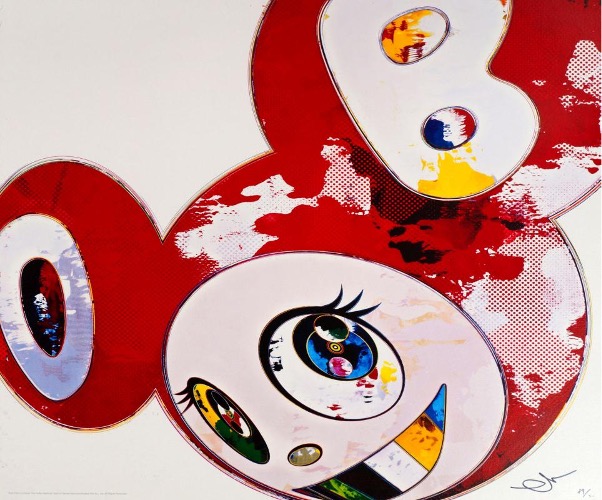
Takashi Murakami, Japanese b.1962- And Then x 6 (Red: The Polke Method), 2013; offset lithograph printed in colours sold at Roseberys Modern & Contemporary Prints & Multiples auction for £775
In 1994, Murakami travelled to New York City to participate in P.S.1 Contemporary Art Center's International Studio Program on a fellowship from the Asian Cultural Council. This time represented a radical breaking point for his career where he started to create a noticeable brand for himself. This included inventing characters that combined aspects of popular cartoons from Japan, Europe, and the US - from smiling flowers, bears and lions to technicolour mushrooms.
"I set out to investigate the secret of market survivability - the universality of characters such as Mickey Mouse, Sonic the Hedgehog, Doraemon, Miffy, Hello Kitty, and their knock-offs, produced in Hong Kong," Murakami wrote for a 2001 retrospective of his work. The result was Mr. DOB, Murakami's most global and enduring character - who sometimes serves as a stand-in for the artist himself. While Murakami’s imagery may appear to present unprecedented characters and forms, many contain explicit art historical references, complex themes of violence, technology, and fantasy and some are even direct contemporary updates on traditional Japanese works of art.
In 1996, he was included in a group exhibition at the gallery Feature. This exhibition marked the beginning of his international acclaim and fame. In the same year, he established the Hiropon Factory, a studio/workshop that in subsequent years grew into an art production and artist management company, now known as Kaikai Kiki Co. Ltd. Like much of Murakami's works, his factory is modelled on both traditional Japanese art workshops, such as the ones that produced the colourful woodblock prints from the Edo period, as well as on Andy Warhol's Factory. At Hiropon assistants trained in various areas of expertise collaborate under the artist's supervision for large-scale, mass-marketed projects.
In 2000 out of defiance for the Western-dominated art world, Murakami created his own movement called Superflat. The term refers both to the flattened compositions that the perspective of historical Japanese artistic movements such as Nihonga, as well as to the flattening or merging of art and commerce. Superflat is Murakami's way of bringing together Japan's history with contemporary pop culture. Its bright and easy eye-candy aesthetic immediately lured a wide audience to Murakami's work. After its creation the Superflat theory soon swept across the contemporary art world, becoming a landmark movement in contemporary Japanese art to this day.
Due to his commercial appeal, his works have been translated onto various other media ranging from keychains and mugs. In 2002 he began a multiyear collaboration with Marc Jacobs on the redesign of the Louis Vuitton monogram. In 2007, Murakami designed the Dropout Bear character for singer Kanye West's album Graduation and directed an animated video for West's song "Good Morning." This shift between fine art and commercial media revealed Murakami's ambition of redefining what a postmodern, international artist can be.
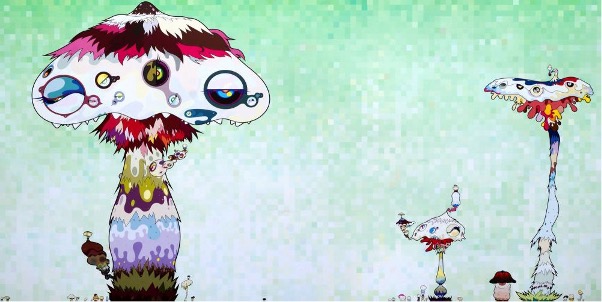
Takashi Murakami, Japanese b.1962- Hypha will cover the world, little by little. We should be able to get our hands on that door to the alien world soon. Wait till we get here!, 2009; offset lithograph on smooth wove paper sold at Roseberys Modern & Contemporary Prints & Multiples auction for £625
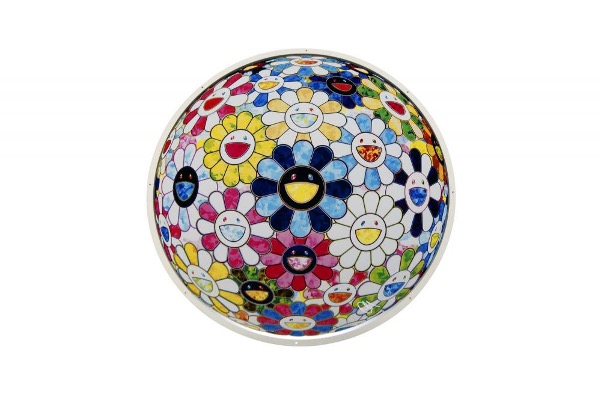
Takashi Murakami, Japanese b.1962- The Flowerball's Painterly Challenge, 2014 offset lithograph printed in colours with high gloss varnish on smooth wove sold at Roseberys Modern & Contemporary Prints & Multiples auction for £1,187
Murakami has achieved global recognition as one of the most prominent contemporary artists of his time, and his work has been featured in numerous solo exhibitions at museums and art institutions around the world. This includes those held at the Mori Art Museum in Tokyo, Gagosian Gallery in London, the Guggenheim and the Museum in Bilbao. One of his most memorable exhibitions to date being the exhibition which was held at the Château de Versailles, France in 2010 ‘MURAKAMI VERSAILLES’ . The exhibition included 22 pieces installed throughout the estate, involving 11 artworks created especially for the exhibition. The exhibition caused a stir throughout the art world with the bold juxtaposition of his contemporary, cartoon aesthetic against the grandiosity of French rococo. Along with creating paintings and sculptures, he has hosted art fairs for emerging artists, curated exhibitions, and made films featuring his many characters and motifs.
Murakami's work celebrates commerce, and commerce returns the favour. On November 11, 2003, ArtNews described Murakami's work as being in great demand. Hiropon (1997), a life-sized satirical sculpture sold for $427,500 at Christie's auction house in May 2002. Miss ko2 (1996), a 6-foot-tall model of an anime-inspired blonde girl sold for $567,500 in 2003, and was put up for auction again in 2010, where it sold for 22.9 million HKD. In May 2008, My Lonesome Cowboy (1998), an anime-inspired sculpture created earlier in his career, sold for $15.2 million at Sotheby's. His collectors include various celebrities such as South Korean superstar musician G-Dragon, Leonardo DiCaprio, Kylie Jenner and Pharrell Williams.
Many of Takashi Murakami’s works have been sold at Roseberys. If you would like to be notified about the Takashi Murakami lots coming up for auction register an account to set up key word alerts.
Takashi Murakami, Japanese b.1962- Flowers Blooming in T...
Price Realised: £6,240
Takashi Murakami, Japanese b.1962- Flowers Blooming in T...
Price Realised: £5,460
Takashi Murakami, Japanese b.1962- Flowers Blooming in T...
Price Realised: £3,900
Takashi Murakami, Japanese b.1962- Flowers of Hope, 2020...
Price Realised: £2,470
Takashi Murakami, Japanese b.1962- Field of Flowers, 202...
Price Realised: £2,210
Takashi Murakami, Japanese b.1962- Time Bokan- black, ...
Price Realised: £2,340
Takashi Murakami, Japanese b.1962- Time Bokan- black, Time Bokan- gree...
Price Realised: £2,340
Takashi Murakami, Japanese b.1962- Time Bokan- black, ...
Price Realised: £2,340
Takashi Murakami, Japanese b. 1962- School Entrance Ceremony, 2021; archiv...
Price Realised: £3,380
Takashi Murakami, Japanese b. 1962- School Entrance Ceremony, 2021; archiv...
Price Realised: £2,860
Takashi Murakami, Japanese b.1962- Doraemon's Daily Life; Doraemon in the ...
Price Realised: Unsold Lot
Takashi Murakami, Japanese b.1962- Doraemon, Hip Hip Hurrah; Here we go; T...
Price Realised: Unsold Lot
Takashi Murakami & Virgil Abloh, Japanese b.1962 & American b.198...
Price Realised: £1,820
Takashi Murakami & Virgil Abloh, Japanese b.1962 & American b.198...
Price Realised: £1,690
Takashi Murakami & Virgil Abloh, Japanese b.1962 & American b.198...
Price Realised: £1,820
Takashi Murakami, Japanese b.1962- 4 Arhats, One With Fo...
Price Realised: £4,160
Takashi Murakami, Japanese b.1962- Doraemon's Daily ...
Price Realised: £2,340
Takashi Murakami, Japanese b.1962- Doraemon: Here We Go!...
Price Realised: £2,340
Takashi Murakami, Japanese b.1962- Bokan- black, Bokan- ...
Price Realised: £3,640
Takashi Murakami, Japanese b.1962- Bokan- black, Bokan- ...
Price Realised: £2,340
Takashi Murakami, Japanese b.1962- Black Flowers and Sku...
Price Realised: £2,210
Takashi Murakami, Japanese b.1962- Time Bokan- blue, Bok...
Price Realised: £1,560
Takashi Murakami, Japanese b. 1962- Inside the Rainbow’s Heart; offset l...
Price Realised: £1,820
Takashi Murakami, Japanese b. 1962- Burying my face in the field of flower...
Price Realised: £1,560
Takashi Murakami, Japanese b. 1962-Beyond Dimensions;offset lithograph, co...
Price Realised: £1,690
Takashi Murakami, Japanese b. 1962- Flowerball: Colorful, Miracle, Sparkle...
Price Realised: £1,560
Takashi Murakami, Japanese b.1962-Inside the Rainbow’s Heart;offset lith...
Price Realised: £2,600
Takashi Murakami, Japanese b.1962-Beyond Dimensions;offset lithograph, col...
Price Realised: £1,820
Takashi Murakami, Japanese b. 1962-Flowerball: Colorful, Miracle, Sparkle;...
Price Realised: £1,560
Takashi Murakami, Japanese b.1962-Burying My Face in the Field of Flower;o...
Price Realised: £1,690
Takashi Murakami, Japanese b. 1962-Flower Ball (3D) Cosmos;offset lithogra...
Price Realised: £1,105
Takashi Murakami, Japanese b.1962- Inside the Rainbow’s Heart; offset li...
Price Realised: Unsold Lot
Takashi Murakami, Japanese b. 1962- Jelly Fish Eyes; offset lithograph, s...
Price Realised: Unsold Lot
Takashi Murakami, Japanese b. 1962-Awakening;offset lithograph, cold stamp...
Price Realised: £1,950
Takashi Murakami, Japanese b. 1962- Jelly Fish Eyes; offset lithograph, s...
Price Realised: £1,300
Takashi Murakami, Japanese b.1962-Let us Devote Our Hearts;offset lithogra...
Price Realised: £1,430
Takashi Murakami, Japanese b.1962-Fireball;offset lithograph, cold stamp a...
Price Realised: £1,430
Takashi Murakami, Japanese b.1962-Inside the Soul;offset lithograph, cold ...
Price Realised: £1,430
Takashi Murakami, Japanese b.1962-Flowers of Gratitude;offset lithograph, ...
Price Realised: £1,430
Takashi Murakami, Japanese b.1962- Fireball; offset lithograph, cold stamp...
Price Realised: £1,300
Takashi Murakami, Japanese b. 1962- Beyond Dimensions; offset lithograph, ...
Price Realised: £1,430
Takashi Murakami, Japanese b.1962- Burying My Face in the Field of Flower;...
Price Realised: £1,300
Takashi Murakami, Japanese b.1962- Ensō: A World Fill...
Price Realised: £1,690
Takashi Murakami, Japanese b.1962- Ensō: Facing the P...
Price Realised: £1,430
Takashi Murakami, Japanese b.1962- Infinity and Davey Jo...
Price Realised: £1,820
Takashi Murakami, Japanese b.1962- Wouldn't it Be Ni...
Price Realised: £2,210
Takashi Murakami, Japanese b.1962- Wouldn't it Be Ni...
Price Realised: £1,300
Takashi Murakami, Japanese b.1962- Bokan- Camouflage P...
Price Realised: £1,560
Takashi Murakami, Japanese b. 1962- Thoughts on Picasso; offset lithograph...
Price Realised: Unsold Lot
Takashi Murakami, Japanese b. 1962- Thoughts on Picasso; offset lithograph...
Price Realised: £1,430
Takashi Murakami, Japanese b. 1962- Flowerball Multicolour; offset lithogr...
Price Realised: £1,690
Takashi Murakami, Japanese b.1962- Inside the Rainbow’s Heart; offset li...
Price Realised: £1,430
Takashi Murakami, Japanese b. 1962- If I Could Only Do This, If I Could Onl...
Price Realised: Unsold Lot
Takashi Murakami, Japanese b. 1962- An Homage to Yves Klein, 2012; offset ...
Price Realised: £1,300
Takashi Murakami, Japanese b.1962- Lime Green - Time; Pink and blue- Time;...
Price Realised: Unsold Lot
Takashi Murakami, Japanese b.1962- Miyo ! the world of Yomi; three offset ...
Price Realised: £1,560
Takashi Murakami, Japanese b.1962- Thoughts on Matisse, 2015; offset litho...
Price Realised: £1,170
Takashi Murakami, Japanese b.1962- Jellyfish Eyes - Black 5, 2004; offset ...
Price Realised: Unsold Lot
Takashi Murakami, Japanese b. 1962- Me Among The Supernatural, 2013; offse...
Price Realised: £910
Takashi Murakami, Japanese b. 1962- Flower, 2002; Flower 2, 2002; each o...
Price Realised: £1,105
Takashi Murakami, Japanese b.1962- Blue Velvet and Rose Velvet; Flower Ba...
Price Realised: Unsold Lot
Takashi Murakami Japanese b.1962- "An Homage to Monogold...
Price Realised: £1,040
Takashi Murakami Japanese b.1962- "An Homage to Monopink...
Price Realised: £1,560
Takashi Murakami, Japanese b.1962- 12 Arhats and Assig...
Price Realised: £910
Takashi Murakami, Japanese b.1962- Clairvoyance and 4 ...
Price Realised: £845
Takashi Murakami, Japanese b.1962- Reversed Double Helix...
Price Realised: £910
Takashi Murakami, Japanese b.1962- Cosmos and Playful An...
Price Realised: £910
Takashi Murakami, Japanese b.1962- 12 Arhats and Assigna...
Price Realised: £1,105
Takashi Murakami, Japanese b.1962- Clairvoyance and 4 Ar...
Price Realised: £910
Takashi Murakami, Japanese b.1962- Behold! Tis the Nethe...
Price Realised: £910
Takashi Murakami, Japanese b.1962- Doraemon: Here We G...
Price Realised: £936
Takashi Murakami, Japanese b.1962- Doraemon: Thank You...
Price Realised: £936
Takashi Murakami, Japanese b.1962- Doraemon: Hip Hip H...
Price Realised: £936
Takashi Murakami, Japanese b.1962- Doraemon: Here We G...
Price Realised: £910
Takashi Murakami, Japanese b.1962- Doraemon: Thank You...
Price Realised: £910
Takashi Murakami, Japanese b.1962- Doraemon: Hip Hip H...
Price Realised: £2,080
Takashi Murakami, Japanese b.1962- Vapor trail, offset lith...
Price Realised: £4,160
Takashi Murakami, Japanese b.1962-Kansei: Like The River’s Flow;signed ci...
Price Realised: £1,300
Takashi Murakami, Japanese b.1962-Kansei: Abstraction;signed circular litho...
Price Realised: £1,430
Takashi Murakami, Japanese b.1962- Inside the Soul; offset lithograph, col...
Price Realised: £1,170
Takashi Murakami, Japanese b.1962-Let us Devote Our Hearts;offset lithogra...
Price Realised: £1,300
Takashi Murakami, Japanese b. 1962- Flowerball: Colorful, Miracle, Sparkle...
Price Realised: £1,820
Takashi Murakami, Japanese b.1962- Flowers of Gratitude; offset lithograph...
Price Realised: £1,040
Takashi Murakami, Japanese b.1962- My Sincerity To You, 2023; offset lit...
Price Realised: £1,690
Takashi Murakami, Japanese b.1962- Kōrin Flowers and Water, 2023; offse...
Price Realised: £1,300
Takashi Murakami, Japanese b.1962- And Then x6 (Red: The Superflat Method),...
Price Realised: Unsold Lot
Takashi Murakami, Japanese b.1962- Cosmos, 2000; offset lithograph with si...
Price Realised: Unsold Lot
Takashi Murakami, Japanese b.1962- Jellyfish Eyes White 4, 2006; offset li...
Price Realised: Unsold Lot
Takashi Murakami, Japanese b.1962- Jellyfish Eyes - Black 3, 2004; offset ...
Price Realised: £1,040
Takashi Murakami, Japanese b.1962- Blue Velvet and Rose Velvet; Flower Ball...
Price Realised: £1,105
Takashi Murakami, Japanese b.1962- Many Things Await Bey...
Price Realised: £1,430
Takashi Murakami, Japanese b.1962- On an Endless Journey...
Price Realised: £1,430
Takashi Murakami, Japanese b.1962- Anywhere Door (Dokode...
Price Realised: £1,300
Takashi Murakami, Japanese b.1962- We Came to the Field ...
Price Realised: £1,300
Takashi Murakami, Japanese b.1962- Doraemon's Daily ...
Price Realised: £910
Takashi Murakami, Japanese b.1962- Mr. Fujiko F. Fujio a...
Price Realised: £780
Takashi Murakami, Japanese b.1962- Doraemon in the Field...
Price Realised: £780
Takashi Murakami, Japanese b.1962- We Came to the Fiel...
Price Realised: £1,170
Takashi Murakami, Japanese b.1962- Doraemon's Daily ...
Price Realised: £910
Takashi Murakami, Japanese b.1962- Mr. Fujiko F. Fujio a...
Price Realised: £975
Takashi Murakami, Japanese b.1962- Doraemon in the Field...
Price Realised: £780
Takashi Murakami, Japanese b.1962- Many Things Await Bey...
Price Realised: £780
Takashi Murakami, Japanese b.1962- On an Endless Journey...
Price Realised: £780
Takashi Murakami, Japanese b.1962- Anywhere Door (Dokode...
Price Realised: £845
Takashi Murakami, Japanese b.1962- Time Bokan- green, ...
Price Realised: £819
Takashi Murakami, Japanese b.1962- RED-TIME, PINK-TIME...
Price Realised: £780
Takashi Murakami, Japanese b.1962- Time Bokan- green, ...
Price Realised: £780
Takashi Murakami, Japanese b.1962- RED-TIME, PINK-TIME...
Price Realised: £845
Takashi Murakami, Japanese b.1962- Time Bokan- green, ...
Price Realised: £1,040
Takashi Murakami, Japanese b.1962- The Flowerball'...
Price Realised: £1,235
Takashi Murakami, Japanese b.1962- Yoshiko and the Creat...
Price Realised: £1,820
Takashi Murakami, Japanese b.1962- I Do Not Rule My Drea...
Price Realised: £910
Takashi Murakami, Japanese b.1962- MGST, 1962-2011, 20...
Price Realised: £650
Takashi Murakami, Japanese b.1962- MGST, 1962-2011, 20...
Price Realised: £715
Takashi Murakami, Japanese b.1962- MGST, 1962-2011, 20...
Price Realised: £780
Takashi Murakami, Japanese b.1962- MGST, 1962-2011, 2011; offset l...
Price Realised: £650
Takashi Murakami, Japanese b.1962- MGST, 1962-2011, 2011; offset lithograph...
Price Realised: £845
Takashi Murakami, Japanese b.1962- MGST, 1962-2011, 2011; offset lithograph...
Price Realised: £715
Takashi Murakami, Japanese b. 1962- Flowerball; An Homage to Monogold; Flo...
Price Realised: £1,105
Takashi Murakami, Japanese b.1962- Blue Velvet and Rose Velvet, 2020; Pos...
Price Realised: £780
Takashi Murakami, Japanese b.1962- Acupuncture, Checkers/Flowers, 2008; o...
Price Realised: £1,040
Takashi Murakami, Japanese b.1962- Jellyfish Eyes - Black 5, 2004; offset ...
Price Realised: £780
Takashi Murakami, Japanese b.1962- Jellyfish Eyes- White1, 2006; offset li...
Price Realised: £780
Takashi Murakami, Japanese b.1962- Jellyfish Eyes- Black 1, 2004; offset l...
Price Realised: £780
Takashi Murakami, Japanese b.1962- Jellyfish Eyes- White 2, 2006; offset l...
Price Realised: £780
Takashi Murakami, Japanese b.1962- Jellyfish Eyes- Black 2, 2004; offset l...
Price Realised: £715
Takashi Murakami, Japanese b.1962- And Then x 6 (Red: ...
Price Realised: £806
Takashi Murakami, Japanese b.1962- Hypha will cover th...
Price Realised: £650
Takashi Murakami, Japanese b.1962- Parallel Universe, 20...
Price Realised: £1,300
Takashi Murakami, Japanese b.1962- Flowers Have Bloomed,...
Price Realised: £1,235
Takashi Murakami, Japanese b.1962- Planet 66, 2004; �...
Price Realised: £1,300
Takashi Murakami, Japanese b.1962- Planet 66, 2004; �...
Price Realised: £650
Takashi Murakami, Japanese b.1962- Dumb Compass, 2008; ...
Price Realised: £715
Takashi Murakami, Japanese b.1962- And Then x 6 (Red: ...
Price Realised: £1,170
Takashi Murakami, Japanese b.1962- Spiral, 2014; ...
Price Realised: £780
Takashi Murakami, Japanese b.1962- Brooklyn Museum VIP B...
Price Realised: £572
Takashi Murakami, Japanese b.1962- Parallel Universe, ...
Price Realised: £910
Takashi Murakami, Japanese b.1962- And Then X 6 (blue:...
Price Realised: £1,040
Takashi Murakami, Japanese b.1962- And Then X 6 (blue:...
Price Realised: £1,040
Takashi Murakami, Japanese b.1962- And Then X 6 (blue:...
Price Realised: £910
Takashi Murakami, Japanese b.1962- And Then X 6 (blue: The Polke Method), 2...
Price Realised: £1,820
Takashi Murakami, Japanese b.1962- And Then x6, 2013; offset lithograph in...
Price Realised: £780
Takashi Murakami, Japanese b.1962- We are the jocular clan, 2018; offset l...
Price Realised: Unsold Lot
Takashi Murakami, Japanese b.1962- We are the jocular clan, 2018; offset l...
Price Realised: £715
Takashi Murakami, Japanese b.1962- We are the jocular clan, 2018; offset l...
Price Realised: £975
Takashi Murakami, Japanese b.1962- We are the jocular clan, 2018; offset l...
Price Realised: £650
Takashi Murakami, Japanese b.1962- We are the jocular clan, 2018; offset l...
Price Realised: £845
Takashi Murakami, Japanese b.1962- Jellyfish Eyes- White 3, 2006; offset l...
Price Realised: £546
Takashi Murakami, Japanese b.1962- We are the jocular clan, 2018; offset...
Price Realised: £546
Takashi Murakami, Japanese b.1962- And Then x 727 (Ultra...
Price Realised: £1,430
Takashi Murakami, Japanese b.1962- MCRST, 1962-2011; ...
Price Realised: £1,430
Takashi Murakami, Japanese b.1962- MCRST, 1962-2011; ...
Price Realised: £715
Takashi Murakami, Japanese b.1962- And Then x 6 (Lapis L...
Price Realised: £975
Takashi Murakami, Japanese b.1962- Yo, Hakuin, 2010; ...
Price Realised: £520
Takashi Murakami, Japanese b.1962- Yo, Hakuin, 2010; ...
Price Realised: £442
Takashi Murakami, Japanese b.1962- Flower HOLLOW, 2015; ...
Price Realised: £910
Takashi Murakami, Japanese b.1962- Genome No.10 7x2 12...
Price Realised: £468
Takashi Murakami, Japanese b.1962- Behold! Tis The Net...
Price Realised: £468
Takashi Murakami, Japanese b.1962- Genome No.10 7x2 12...
Price Realised: £494
Takashi Murakami, Japanese b.1962- Behold! Tis The Net...
Price Realised: £650
Takashi Murakami, Japanese b.1962- Behold! Tis The Net...
Price Realised: £598
Takashi Murakami, Japanese b.1962- Behold! Tis The Net...
Price Realised: £598
Takashi Murakami, Japanese b. 1962- Time Bokan Green, 20...
Price Realised: £910
Takashi Murakami, Japanese b. 1962- Time Bokan Green; LI...
Price Realised: £910
Takashi Murakami, Japanese b.1962- Jellyfish Eyes- White 1, 2006; offset li...
Price Realised: Unsold Lot
Takashi Murakami, Japanese b.1962- Jellyfish Eyes- White 1, 2006; offset li...
Price Realised: £468
Takashi Murakami, Japanese b.1962- Jellyfish Eyes- White 1, 2006; offset li...
Price Realised: £494
Takashi Murakami, Japanese b.1962- Playful And Carefre...
Price Realised: £650
Takashi Murakami, Japanese b.1962- Mirroring Your Imag...
Price Realised: £624
Takashi Murakami, Japanese b.1962- Mirroring Your Image:...
Price Realised: £338
Takashi Murakami, Japanese b.1962- Jellyfish Eyes- Whi...
Price Realised: £468
Takashi Murakami, Japanese b.1962- Jellyfish Eyes- Whi...
Price Realised: £650
Takashi Murakami, Japanese b.1962- Playful And Carefre...
Price Realised: £494
Takashi Murakami, Japanese b.1962- Jellyfish Eyes- Whi...
Price Realised: £910
Takashi Murakami, Japanese b.1962- Jellyfish Eyes- Whi...
Price Realised: £1,105
Takashi Murakami, Japanese b.1962- RED-TIME, 2008; ...
Price Realised: £494
Takashi Murakami, Japanese b.1962- RED-TIME, 2008; offset lithographs in co...
Price Realised: £494
Takashi Murakami, Japanese b.1962- We are the jocular clan, 2018; offset l...
Price Realised: £520
Takashi Murakami, Japanese b.1962- We are the jocular clan, 2018; offset l...
Price Realised: £520
Takashi Murakami, Japanese b.1962- Lime Green - Time; Pink and blue- Time;...
Price Realised: £1,105
Takashi Murakami, Japanese b.1962- Blue Velvet and Rose Velvet; lithograp...
Price Realised: £442
Takashi Murakami, Japanese b.1962- Octopus Eats Its Ow...
Price Realised: £390
Takashi Murakami, Japanese b.1962- RED-TIME, 2008; ...
Price Realised: £910
Takashi Murakami, Japanese b. 1962- If I Could Only Do This, If I Could Onl...
Price Realised: £520
Would you like to receive personalised keyword alerts when new catalogues go live. If so, please indicate these below
Set a password to save your keyword alerts
Passwords are a minimum of 7 characters and must include an upper case letter, a lower case letter, a number and a special character (e.g., !@#$%^&*).

Roseberys, 70/76 Knights Hill London
SE27 0JD, United Kingdom
Opening Hours Monday - Friday 9.30am - 5pm
© Copyright 2023 Roseberys All rights reserved
If you have a RoseberysLive account, your username is now your email address.
or
As a buyer you will be able to register for auctions, leave bids, bid live online, create a wishlist of your favourite lots, sign up for customised keyword email alerts, get preferred recommendations, and view and pay your invoices.
As a seller you will be able to easily set up your client account, view all your pre and post sale documents, and select your preferences.
Alternatively, if you just wish to receive personalised keyword alerts when new catalogues go live, add lots to your wishlist , and set newsletter preferences create a ‘lite’ account.

